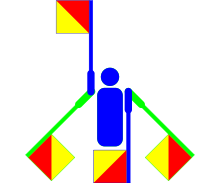Gerald Holtom
Gerald Herbert Holtom (20 January 1914 – 18 September 1985[1][2][3][4]) was a British professional designer and artist. In 1958 he designed the logo of the British Campaign for Nuclear Disarmament (CND), which became an international peace symbol.[5]
| Anti-nuclear movement |
|---|
 |
| By country |
| Lists |
Holtom was a graduate of the Royal College of Art and had been a conscientious objector in World War II.[1] In 1958 he was working for the Ministry of Education.[6] He designed the nuclear disarmament logo for the first Aldermaston March, organised by the Direct Action Committee against Nuclear War in Easter 1958 (4–7 April).
Holtom brought the design, unsolicited, to the chairperson of his local anti-nuclear group in Twickenham, and alternative versions were shown at the inaugural meeting of the London CND.[6] "The first mark on paper, according to Mr Holtom, was a white circle within a black square, followed by various versions of the Christian cross within the circle. But the cross, for these people, had too many wrong associations - with the Crusaders, with military medals, with the public blessing by an American chaplain of the plane that flew to Hiroshima - and eventually the arms of the cross were allowed to drop, forming the composite basic semaphore signal for the letters N and D, and at the same time a gesture of human despair against the background of a round globe. Eric Austen, who adapted the symbol for Holtom's waterproof "lollipops" on sticks to ceramic lapel badges, is said to have "discovered that the 'gesture of despair' motif had long been associated with 'the death of man', and the circle with 'the unborn child'."[6][7]
The logo was not copyrighted and later became known in the wider world as a general-purpose peace symbol.[8][9] The design was a combination of the letters "N" (two arms outstretched pointing down at 45 degrees) and "D" (one arm upraised above the head) of the flag semaphore alphabet, standing for nuclear disarmament.[10]
It was at the Peace News office at 3 Blackstock Road, London N4 (above Housmans Bookshop) that the CND peace symbol was adopted.[10]
Holtom had several children, three with his first family: the eldest Peter, a daughter (now also an artist) Anna Scott (née Holtom)[11] and Benjamin.[12] He later fathered a further two children: a son, Darius, and a daughter, Rebecca (also an artist).[13]
-

CND Symbol -

N -

D -

ND
See also
References
- 1 2 Westcott, Kathryn (20 March 2008) "World's best-known protest symbol turns 50" BBC.co.uk (News) (Retrieved: 21 February 2010)
- ↑ Roth, Richard (23 March 2008). "The 50th Anniversary Of The Peace Symbol". CBS Interactive Inc. Retrieved 20 April 2008.
- ↑ Roth, Richard (20 April 2008). "CBS Sunday Morning, 3/23/08, Origin of the Peace Sign (timecode 5:13)". CBS Interactive Inc. Retrieved 20 April 2008.
- ↑ "Holtom gravestone" (bitmap image). Retrieved 20 April 2008.
- ↑ Ken Kolsbun with Mike Sweeney Peace: The Biography of a symbol (Retrieved: 26 December 2010)
- 1 2 3 Christopher Driver, The Disarmers: A Study in Protest, London: Hodder and Stoughton, 1964
- ↑ Koch, R., The Book of Signs, Dover, 1955
- ↑ "Briefings & Information: The CND logo" CNDUK.org (Retrieved: 21 February 2010)
- ↑ McCarthy, Michael (15 October 2005) "Whatever happened to CND?" Independent.co.uk (Retrieved: 21 February 2010)
- 1 2 "Peace Education: The disarmament symbol" CNDUK.org (Retrieved: 21 February 2010)
- ↑ "Father & Daughter still competing after 50 years.......50 Years after her father Gerald Holtom, created the now iconic CND symbol, Anna Scott (nee Holtom)is exhibiting her own works at a Mayfair Gallery". 2008-03-17. Retrieved 2012-06-18.
- ↑ Mackley, Sam (2010-01-23). "My Dad's Birthday". Retrieved 2012-06-18.
- ↑ Sloan, Liam (2008-03-25). "Fifty years of peace symbol". NewburyToday.co.uk. Retrieved 2010-02-22.
External links
- "Peace Symbol History". teachpeace.com.
- Gerald Holtom at Find a Grave